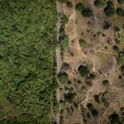1,071 news posts

Climate action
15 Mar 2022
New high-resolution map shows fires caused one third of global forest loss between 2001 and 2019
New high-resolution map shows fires caused one third of global forest loss between 2001 and 2019, published in Frontiers in Remote Sensing

Featured news
14 Mar 2022
Possible treatment for tinnitus? 4 fascinating Frontiers articles you may have missed
By Colm Gorey, Science Communications Manager Image: Shutterstock.com At Frontiers, we bring some of the world’s best research to a global audience. But with tens of thousands of articles published each year, many often fly under the radar. Now, as part of new series each month, Frontiers will highlight just some of those amazing papers you may have missed. 1: New treatment for tinnitus shows promise for further study More than 10% of the world’s population is estimated to live with a condition called tinnitus, where a range of sounds ranging from ringing to buzzing are heard in the ears that never goes away. While ranging in severity, between 0.5% and 3% of people diagnosed with it say their quality of life is impacted, with no known cure. However, researchers in South Korea have published a paper in Frontiers in Neuroscience putting forward hopeful findings that suggest a new treatment method could be possible for subacute and chronic tinnitus. The small study saw 55 patients undergo repeated nerve blocks after stimulation of the trigeminal and facial nerves to modulate the auditory and non-auditory nervous systems via the vestibulocochlear cranial nerve pathways. In more than 87.5% of patients, tinnitus disappeared or […]

Featured news
10 Mar 2022
Climate crisis is making endangered mountain gorillas more thirsty
Climate crisis is making endangered mountain gorillas more thirsty, finds a news study in Frontiers in Conservation Science

Featured news
09 Mar 2022
Ancient art and genetics combine to reveal origin of world’s most expensive spice
By Mischa Dijkstra, Frontiers science writer Harvest of saffron crocuses. Image credit: Petia_is / Shutterstock In a new review, researchers showcase how the first likely depictions of the domesticated saffron crocus date from Bronze Age Greece. This evidence, which suggests that the species was first domesticated in Greece by approximately 1700 BCE, converges with recent genetic studies which showed that its closest wild relative only occurs in Greece. Saffron, the world’s most expensive spice, is extracted from the flowers of the saffron crocus, Crocus sativus. It has been grown for thousands of years in the Mediterranean region. But when and where was saffron first domesticated by our ancestors? In a review in Frontiers in Plant Science, researchers conclude that lines of evidence from ancient art and genetics converge on the same region. “Both ancient artworks and genetics point to Bronze Age Greece, in approximately 1700 BCE or earlier, as the origin of saffron’s domestication,” said Ludwig Mann, one of the leading authors and a PhD student at Technische Universität Dresden, Germany. ► Read original article► Download original article (pdf) The genus Crocus, with approximately 250 species, ranges from South and Central Europe and North Africa to Western China. Unlike domesticated saffron, these […]

Featured news
08 Mar 2022
This sustainable solar oven allows rural communities to cook without coal or firewood
This sustainable solar oven allows rural communities to cook without coal or firewood, published in Frontiers in Energy Research

Featured news
04 Mar 2022
DNA barcoding identifies endangered shark species secretly added to pet food
DNA barcoding identifies endangered shark species secretly added to pet food, shows a new study published in Frontiers in Marine Science

Engineering
03 Mar 2022
4 articles you need to check out on the future of building engineering
By Colm Gorey, Science Communications Manager Image: Robert Kneschke/Shutterstock.com The infrastructure that makes up our towns and cities is undergoing a technological and scientific revolution. Now, to help shine a light on some of these significant changes and what it means for engineering, Frontiers highlights just four of the latest research articles helping shape the future of construction. For most of the last century, humanity as a species was focused almost solely on building larger cities as fast as possible and with little thought on its impact to the environment. Now, with the climate crisis an unavoidable reality, this old style of thinking is being replaced by not only more sustainable engineering practices, but ones that revolutionize our very understanding of how we build. Here are just four recent articles published to Frontiers from some of the top researchers in their field as part of the Research Topic ‘Horizons in Built Environment‘. Comprehensive review on the dynamic and seismic behavior of flat-bottom cylindrical silos filled with granular material Storage containers of bulk material are known as bins, silos or even bunkers. Although there is no globally accepted definition for each of the previous terms, ‘bins’ or ‘bunkers’ are commonly used […]

Psychology
28 Feb 2022
Origins of life and plastic invasions: The most viewed Frontiers news articles of January 2022
By Colm Gorey, Science Communications Manager Image: DisobeyArt/Shutterstock.com Each month, Frontiers shines a spotlight on some of the leading research across a wide range of topics. Here are just some of the highlights that resonated strongly with readers on our news site in the month of January. Likely energy source behind first life on Earth found ‘hiding in plain sight’ Life on Earth arose roughly 4bn years ago. How it arose, and from what energy source is of interest to everyone because we humans like to know where we come from. The team of Prof William Martin at the University Düsseldorf’s Institute of Molecular Evolution investigates early evolution. In a recent paper in Frontiers in Microbiology, they argue that the source of energy required at life’s origin has been hiding in plain sight: under the environmental conditions at deep sea hydrothermal vents, hypothesized to have been the sites where life on Earth originated, the central biosynthetic reactions of life do not require an external energy source. Article link: https://www.frontiersin.org/articles/10.3389/fmicb.2021.793664/full 2. How do we define a well-lived life? First scientific evidence helps us get closer to an answer A transition, such as the beginning of a new year or entering the second half of life, […]

Featured news
25 Feb 2022
Children may instinctively know how to do division even before hitting the books, study finds
By Peter Rejcek, science writer Image: Fizkes/Shutterstock.com Beginning at an early age, children can perform simple mathematical calculations using an intuitive ability to compare and estimate sets of objects. A new study published to Frontiers suggests this approximate number system extends to division. We often think of multiplication and division as calculations that need to be taught in school. But a large body of research suggests that, even before children begin formal education, they possess intuitive arithmetic abilities. A new study published in Frontiers in Human Neuroscience argues that this ability to do approximate calculations even extends to that most dreaded basic math problem – true division – with implications for how students are taught mathematical concepts in the future. The foundation for the study is the approximate number system (ANS), a well-established theory that says people (and even nonhuman primates) from an early age have an intuitive ability to compare and estimate large sets of objects without relying upon language or symbols. For instance, under this non-symbolic system, a child can recognize that a group of 20 dots is bigger than a group of four dots, even when the four dots take up more space on a page. The […]

Neuroscience
24 Feb 2022
3 articles you need to check out on the future of neural circuit research
By Colm Gorey, Science Communications Manager Image: Andrii Vodolazhskyi/Shutterstock.com In an ever-changing field of research such as neural circuits, it can be difficult to keep up with the latest breakthroughs. Now at Frontiers, we highlight just three of the latest research articles to shed more light on how the mind works. The human brain continues to fascinate us, but still hides many mysteries that scientists aim to solve. Among the most studied aspects of the brain is its vast array of neural circuits which carry out a variety of crucial everyday functions in the body, and has inspired computer scientists to build powerful AI systems using artificial neural circuits. Here are just three recent articles published to Frontiers from some of the top researchers in their field as part of the Research Topic ‘Horizons in Neural Circuits’. Endocannabinoid-Mediated Control of Neural Circuit Excitability and Epileptic Seizures Epilepsy is one of the most common neurological disorders, with an incidence of 50.4 per 100,000 people per year. Although many drugs and surgical treatments are available for the treatment of epilepsy, approximately 30% of patients continue to have uncontrolled seizures despite treatment. One of the most important discoveries in the field of cannabinoid […]

Climate action
23 Feb 2022
Sharp drop in flower abundance caused by climate crisis will leave pollinators searching further for food
By Mischa Dijkstra, Frontiers science writer Image credit: Ellen D Moss Researchers simulated the warmer, wetter conditions predicted for northern Europe under climate change, by locally heating agricultural fields by 1.5 ºC and increasing irrigation by 40%. These conditions immediately lead to changes in the community of wildflowers and their associated insects. Most plant species were ‘losers’: they grew fewer flowers, secreted less nectar, and set fewer or lighter seeds. This reduced the food resources for pollinators, stimulating them to visit a wider range of plants. It is predicted that global average temperatures will have risen by between 0.9 and 2.0 ºC around the middle of this century, according to the IPCC’s intermediate emission scenario RCP4.5. As a result, many species, especially specialists with highly specific requirements for food, habitat, and reproduction, won’t be able to adapt. Because approximately 35% of our crops depend on insects for pollination, it is necessary to study impact of global warming on the fitness of insects and the wildflowers on which they depend for food. Once we understand the likely changes, we may be able to mitigate the negative effects for wild and crop plants. Here, a study by scientists from Newcastle University in […]

Featured news
22 Feb 2022
A replay of life: What happens in our brain when we die?
By Maryam Clark, science writer Image: Okrasiuk/Shutterstock.com Neuroscientists have recorded the activity of a dying human brain and discovered rhythmic brain wave patterns around the time of death that are similar to those occurring during dreaming, memory recall, and meditation. Now, a study published to Frontiers brings new insight into a possible organizational role of the brain during death and suggests an explanation for vivid life recall in near-death experiences. Imagine reliving your entire life in the space of seconds. Like a flash of lightning, you are outside of your body, watching memorable moments you lived through. This process, known as ‘life recall’, can be similar to what it’s like to have a near-death experience. What happens inside your brain during these experiences and after death are questions that have puzzled neuroscientists for centuries. However, a new study published to Frontiers in Aging Neuroscience suggests that your brain may remain active and coordinated during and even after the transition to death, and be programmed to orchestrate the whole ordeal. When an 87-year-old patient developed epilepsy, Dr Raul Vicente of the University of Tartu, Estonia and colleagues used continuous electroencephalography (EEG) to detect the seizures and treat the patient. During these […]

Featured news
21 Feb 2022
Eating vegetables does not protect against cardiovascular disease, finds large-scale study
By Mischa Dijkstra, Frontiers science writer A long-term ‘UK Biobank’ study on almost 400,000 people finds little or no evidence that differences in the amount of consumed cooked or uncooked vegetables affects the risk of cardiovascular disease. When known socio-economic and lifestyle confounding factors are corrected for, the small apparent positive effect that remains could likely also be explained away by further confounders. A sufficient intake of vegetables is important for maintaining a balanced diet and avoiding a wide range of diseases. But might a diet rich in vegetables also lower the risk of cardiovascular disease (CVD)? Unfortunately, researchers from the Nuffield Department of Population Health at the University of Oxford, the Chinese University of Hong Kong, and the University of Bristol found no evidence for this. That the consumption of vegetables might lower the risk of CVD might at first sight seem plausible, as their ingredients such as carotenoids and alpha-tocopherol have properties that could protect against CVD. But so far, the evidence from previous studies for an overall effect of vegetable consumption on CVD has been inconsistent. Now, new results from a powerful, large-scale new study in Frontiers in Nutrition shows that a higher consumption of cooked or […]

Environment
21 Feb 2022
Peace has led to more deforestation in Colombia
By K.E.D. Coan, science writer Difference between reserve and cattle ranches in Colombia. Image credit: Sebastian Di Domenico / Shutterstock In the tropics, when conflict affected countries transition to peace, deforestation often increases. But the reasons behind this trend are neither simple nor generalizable, reports a new study from Colombia. By looking at a range of agricultural and societal drivers at multiple scales, this research shows that different factors promote forest loss. Accounting for these variations will be important for developing more effective conservation strategies in the future. The consequences of peace and armed conflict for deforestation depend on the location, reports a new publication in Frontiers in Environmental Science. Using Colombia as a case study, this work presents one of the most comprehensive studies to date comparing forest loss to drivers such as coca cultivation and cattle farming during periods of peace and conflict. These insights will help make conservation efforts more effective by taking into account the land use, politics and socioeconomics on a local level. “There are other studies that show increased pressure on forests after peace agreements, but our results show that it’s very hard to generalize deforestation in the context of conflict,” said co-author Raphael […]

Featured news
18 Feb 2022
Brains of cosmonauts get ‘rewired’ to adapt to long-term space missions, study finds
Brains of cosmonauts get ‘rewired’ to adapt to long-term space missions, finds study in Frontiers in Neural Circuits